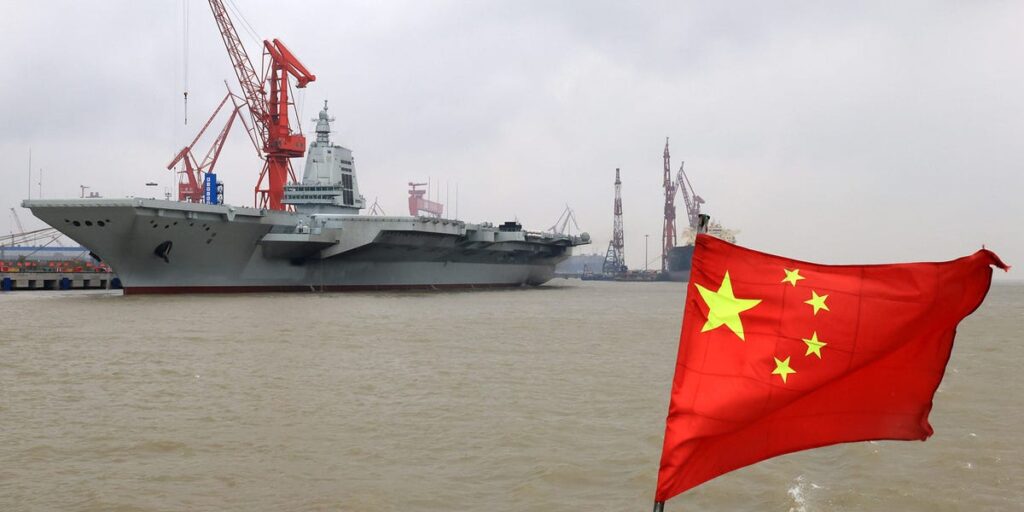Historically, the US aircraft carrier fleet has been a showcase of American military superiority.
Even as the US Navy struggles to extend the lives of its oldest carriers to meet the nation’s requirements, it maintains a fleet of 11 aircraft carriers — more than one-fifth of the 47 total in service worldwide. And that figure does not even count the smaller amphibious assault ships capable of holding squadrons’ worth of aircraft and helicopters.
These amphibious assault ships dwarf the carriers of countries like Spain, Turkey, and South Korea. For American supercarriers in the legacy Nimitz and new Gerald R. Ford classes, there is no size equivalent anywhere in the world.
Yet, one country has designs on US carrier superiority, and size is not the only thing that matters: China has turned heads with its third and newest carrier, the Fujian, which set out on its maiden voyage in May. At 80,000 tons of displacement, this new carrier class is set to be the largest in the world apart from the Nimitz and Ford, with room on the flight deck for up to 60 aircraft.
The Fujian is formidable for other reasons, too. Like US carriers, it has a catapult-assisted takeoff but arrested recovery (CATOBAR) system that gives it more plane-launching power than the “ski jump” carriers used by the UK and other countries. The catapult uses electromagnetic power rather than steam, a cutting-edge technology that debuted with the Ford supercarrier class.
The vessel, however, runs on conventional rather than nuclear power, setting it apart from the rest of the US carrier fleet and making its demand for fuel a potential liability.
These changes might seem small, but maritime observers call them significant.
“While China’s older ski-jump carriers must rely on helicopters with small, rotating radars or land-based aircraft for airborne early warning and control, Fujian will be able to launch larger AEW&C aircraft like the KJ-600, an aircraft similar to the US Navy’s E-2D Hawkeye,” authors J. Michael Dahm and Peter W. Singer wrote for DefenseOne in June.
“The ability to launch the KJ-600 will revolutionize China’s carrier operations, allowing the task group to operate independently, farther from Chinese territory with a powerful airborne radar high overhead offering comprehensive battlespace awareness for hours at a time,” they added.
Bryan McGrath, a retired Navy surface officer and managing director of the consulting firm The FerryBridge Group, told Sandboxx News that the smaller displacement of the new Chinese carrier compared to the US classes matters less to him than what the warship has on board.
McGrath said he was impressed at China’s adoption of electromagnetic launch, which allows for calibration of energy to launch a variety of platforms of different sizes and weights.
“I think they’re catching on,” he said. “They’re early adopters.”
He also noted that the ability of a carrier to launch and recover an airborne early warning aircraft like the E-2D — a hallmark of US carriers, but beyond the capability of American amphibious assault ships — “gives us literally hundreds of miles of command and control around the aircraft carrier.” With the Fujian in the fleet, the Chinese will enjoy a similar advantage.
China’s first carrier, the Liaoning, also underwent a recent refurbishment, while a fourth carrier is believed to be under construction. Some observers think China may have six carriers by the 2030s.
While the US would still have nearly twice as many carriers as China if that prediction comes true, McGrath explained it would make for a different kind of presence and maritime competition. A four-carrier fleet constitutes “a splendid little power projection force,” he said.
“[People of good faith] recognize that a mobile air base is a very useful thing when you wish to be influential here and there,” McGrath said. “If all [China] wanted to do was protect [its] coastline, which is what they did for a long time, they wouldn’t need aircraft carriers. But they want to be able to intimidate their neighbors. They want to be able to intimidate the Philippines and Thailand and Japan and Korea and Australia.”
For the US, carriers have long been a tool of power projection, presence, and warning. This summer saw four carriers deployed globally, including the Dwight D. Eisenhower, which departed for the Red Sea only days after Hamas launched a deadly terror attack on Israel, igniting the ongoing war in Gaza.
China could soon project power the same way, McGrath said. He predicted that the US would see Chinese carriers operating off the coasts of California and Mexico within a decade.
It’s notable that only China and the US, for now, seem to be making real investments in carrier superiority. Russia’s only aging aircraft carrier, the Adm. Kuznetsov, has been in service-life-extension overhaul since 2017. The country had reportedly been considering a new supercarrier, the Shtorm, but the project now seems increasingly unlikely.
Even with two new Ford-class supercarriers set to enter service in the 2030s, some believe carriers are essentially obsolete, a fixture of a bygone era of warfighting. Carrier critics say nuclear submarines offer formidable power projection at considerably less risk and expense.
McGrath isn’t among these critics, though.
“Aircraft carriers exist because airplanes are useful. And because airplanes are useful, it’s nice to have them where you want them,” he said. “And if you tie [airplanes] to the ground, they become easy targets. And so, at the end of the day, an airport that moves remains a very, very smart, wise investment.”
Read more from Sandboxx News
Read the full article here














